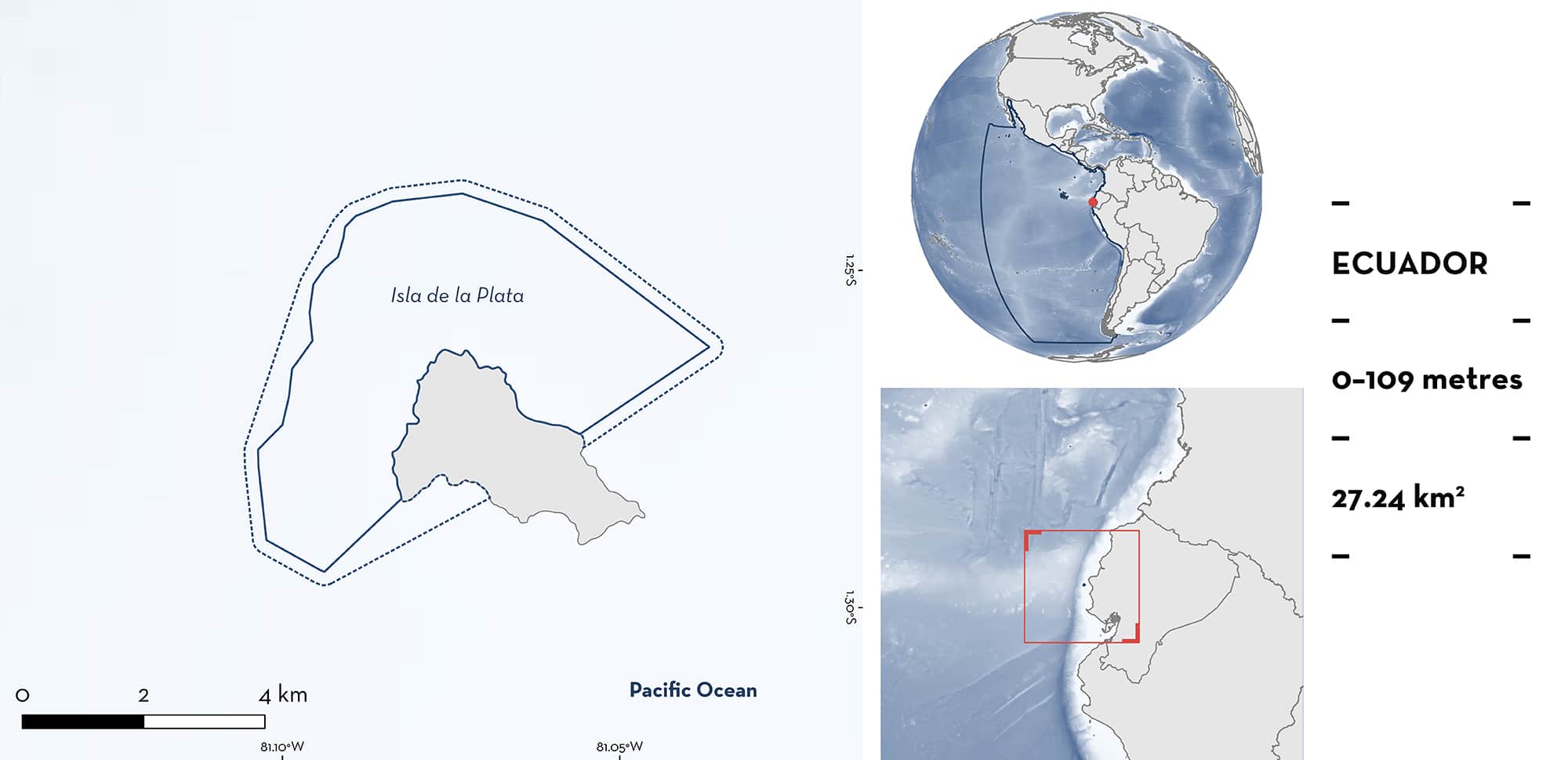ISRA FACTSHEETS
ISRA FACTSHEETS
CENTRAL AND SOUTH AMERICAN PACIFIC REGION
Isla de la Plata
Summary
Isla de la Plata is a small island located ~25 km from mainland Ecuador within the Pacific Central-American Coastal Large Marine Ecosystem. It is situated within the Parque Nacional Machalilla and overlaps with an Ecologically or Biologically Significant Marine Area, the Carnegie Range-Equatorial Front. The area is located on the continental shelf, with surrounding waters characterised by sandy benthos with coral and rocky reef patches to around 30 m depth. In this area there are: threatened species and undefined aggregations (Oceanic Manta Ray Mobula birostris).
Download factsheet
Isla de la Plata
DESCRIPTION OF HABITAT
Isla de la Plata is a small island located ~25 km from mainland Ecuador within the Pacific Central-American Coastal Large Marine Ecosystem. It is situated within the Parque Nacional Machalilla (Machalilla National Park) and overlaps with an Ecologically or Biologically Significant Marine Area, the Carnegie Ridge-Equatorial Front. The area is located on the continental shelf, approximately 5 km from the shelf-edge, where the depth (around 200 m) drops sharply. The surrounding waters are characterised by sandy benthos with coral and rocky reef patches to around 30 m depth. The island is fringed with shallow rocky reefs between 5 and 15 m depth with inter-dispersed sandy areas.
The area encompasses the north and west sides of the island, where the bathymetry rapidly descends to >100 m (Harty et al. 2022). It is influenced by the Humboldt Current System, where the merger of coastal and equatorial currents generates upwelling, resulting in high productivity, especially during June–September when the Equatorial Front (the transition zone between water-masses characterised by a large temperature gradient) is at its strongest (Flachier et al. 1997). The increased productivity leads to high zooplankton abundance, which supports a large and diverse food web (Pennington et al., 2006). Inter-annual variability is driven primarily by the El Niño–Southern Oscillation (Burgess et al. 2017).
This Important Shark and Ray Area is delineated from inshore surface waters to a depth of 109 m based on the maximum depth range of the habitat used by the Qualifying Species in the area.
CRITERION A
VULNERABILITY
One Qualifying Species considered threatened with extinction according to the IUCN Red List of Threatened SpeciesTM regularly occurs in the area. This is the Endangered Oceanic Manta Ray (Marshall et al. 2022).
CRITERION C
SUB-CRITERION C5 – UNDEFINED AGGREGATIONS
Isla de la Plata is an important aggregation area for Oceanic Manta Rays. This area hosts the largest known global population of Oceanic Manta Rays, which occur seasonally between June and October (Burgess 2017; Harty et al. 2022). Photo-identification data from 2005 to 2018 has recorded over 2,800 individuals, with estimated annual abundances of 949–7,650 females and 5,226–9,340 males (Harty et al. 2022). Multi-year resightings of 158 individuals were recorded, with a 13-year maximum period between resightings of an individual. Visual estimates of maturity for males classed 82.5% as mature, 8.4% as subadults, 1.2% juveniles, with 6.9% unknown (Harty et al. 2022).
Drivers for the aggregation are poorly understood, but research suggests that Isla de la Plata provides both a good cleaning and social environment during the day, and the Island’s proximity to the continental shelf-edge provides Oceanic Manta Rays with access to productive nearby habitats (continental shelf edge) to feed during the night (Burgess et al. 2016; Burgess et al. 2017; Guerrero & Hearn 2017).
Download factsheet
SUBMIT A REQUEST
ISRA SPATIAL LAYER REQUEST
To make a request to download the ISRA Layer in either a GIS compatible Shapefile (.shp) or Google Earth compatible Keyhole Markup Language Zipped file (.kmz) please complete the following form. We will review your request and send the download details to you. We will endeavor to send you the requested files as soon as we can. However, please note that this is not an automated process, and before requests are responded to, they undergo internal review and authorization. As such, requests normally take 5–10 working days to process.
Should you have questions about the data or process, please do not hesitate to contact us.


